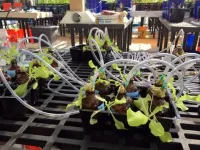Buckyballs on DNA for harvesting light
Supramolecular structure boosts efficiency of light harvesting for solar cells
2021-02-24
(Press-News.org) Organic molecules that capture photons and convert these into electricity have important applications for producing green energy. Light-harvesting complexes need two semiconductors, an electron donor and an acceptor. How well they work is measured by their quantum efficiency, the rate by which photons are converted into electron-hole pairs.
Quantum efficiency is lower than optimal if there is "self-quenching", where one molecule excited by an incoming photon donates some of its energy to an identical non-excited molecule, yielding two molecules at an intermediate energy state too low to produce an electron-hole pair. But if electron donors and acceptors are better spaced out, self-quenching is limited, so that quantum efficiency improves.
In a new paper in Frontiers in Chemistry, researchers from the Karlsruhe Institute of Technology (KIT) synthesize a novel type of organic light-harvesting supramolecule based on DNA. The double helix of DNA acts as a scaffold to arrange chromophores (i.e. fluorescent dyes) - which function as electron donors - and "buckyballs" - electron acceptors - in three dimensions to avoid self-quenching.
"DNA is an attractive scaffold for building light-harvesting supramolecules: its helical structure, fixed distances between nucleobases, and canonical base pairing precisely control the position of the chromophores. Here we show that carbon buckyballs, bound to modified nucleosides inserted into the DNA helix, greatly enhance the quantum efficiency. We also show that the supramolecule's 3D structure persists not only in the liquid phase but also in the solid phase, for example in future organic solar cells," says lead author Dr Hans-Achim Wagenknecht, Professor for Organic Chemistry at Karlsruhe Institute of Technology (KIT).
DNA provides regular structure, like beads on a helical string
As scaffold, Wagenknecht and colleagues used single-stranded DNA, deoxyadenosine (A) and thymine (T) strands 20 nucleotides long. This length was chosen because theory suggests that shorter DNA oligonucleotides wouldn't assemble orderly, while longer ones wouldn't be soluble in water. The chromophores were violet-fluorescent pyrene and red-fluorescent Nile red molecules, each bound noncovalently to a single synthetic uracil (U)-deoxyribose nucleoside. Each nucleoside was base-paired to the DNA scaffold, but the order of pyrenes and Nile reds was left to chance during self-assembly.
For the electron acceptors, Wagenknecht et al. tested two forms of "buckyballs" - also called fullerenes - which are known to have an excellent capacity for "quenching" (accepting electrons). Each buckyball was a hollow globe built from interlocking rings of five or six carbon atoms, for a total of 60 carbons per molecule. The first form of buckyball tested binds nonspecifically to the DNA through electrostatic charges. The second form - not previously tested as an electron acceptor - was covalently bound via a malonic ester to two flanking U-deoxyribose nucleosides, which allowed it to be base-paired to an A nucleotide on the DNA.
High quantum efficiency, including in solid phase
The researchers confirmed experimentally that the 3D structure of the DNA-based supramolecule persists in solid phase: a crucial requirement for applications in solar cells. To this end, they tested supramolecules with either form of buckyballs as the active layer in a miniature solar cell. The constructs showed excellent charge separation - the formation of a positive hole and negative electron charge in the chromophore and their acceptance by nearby buckyballs - with either form of buckyball, but especially for the second form. The authors explain this from the more specific binding, through canonical base-pairing, to the DNA scaffold by the second form, which should result in a smaller distance between buckyball and chromophore. This means that the second form is the better schoice for use in solar cells.
Importantly, the authors also show that the DNA-dye-buckyball supramolecule has strong circular dichroism, that is, it is much more reactive to left- than to right-handed polarized light, due to its complex 3D helical structure - even in the solid phase.
"I don't expect that everyone will have solar cells with DNA on their roof soon. But the chirality of DNA will be interesting: DNA-based solar cells might sense circularly polarized light in specialized applications," concludes Wagenknecht.
INFORMATION:
ELSE PRESS RELEASES FROM THIS DATE:
2021-02-24
BINGHAMTON, NY -- Ancestry estimation -- a method used by forensic anthropologists to determine ancestral origin by analyzing bone structures -- is rooted in "race science" and perpetuates white supremacy, according to a new paper by a forensic anthropologist at Binghamton University, State University of New York.
By themselves, bones seem somewhat uniform to the untrained eye. They lack the traits we so often use to categorize fellow humans: hair texture, the shape of nose and eye, skin pigmentation.
Forensic anthropologists know that race isn't based in biological fact, but in a history and culture that assigns meaning to physical traits that occur among different ...
2021-02-24
Carbon nanotubes are tiny. They can be a hundred thousand times smaller than the width of a human hair. But they have huge potential.
Products manufactured using carbon nanotubes include rebar for concrete, sporting goods, wind turbines, and lithium batteries, among others.
Potential uses of carbon nanotubes could extend to diverse fields, such as agriculture, biomedicine and space science.
But as we use more carbon nanotubes to make things, we also increase the chances that these nanotubes enter different environments and ecosystems.
"That makes it important to understand how ...
2021-02-24
February 24, 2021 - The second study published in as many months has identified another reason to add more mushrooms to the recommended American diet. The new research , published in Food & Nutrition Research (February 2021), examined the addition of mushrooms to U.S. Department of Agriculture (USDA) Food Patterns resulting in the increase of several micronutrients including shortfall nutrients, while having a minimal to zero impact on overall calories, sodium or saturated fat.
Dr. Victor L. Fulgoni III and Dr. Sanjiv Agarwal looked at the nutritional ...
2021-02-24
Small changes to people's writing style can reveal which social group they "belong to" at a given moment, new research shows.
Groups are central to human identity, and most people are part of multiple groups based on shared interests or characteristics - ranging from local clubs to national identity.
When one of these group memberships becomes relevant in a particular situation, behaviour tends to follow the norms of this group so that people behave "appropriately".
The new study - by the University of Exeter, Imperial College London, University College London and Lancaster University - demonstrates that group normative behaviour is reflected in a person's writing style.
It also shows that assessing ...
2021-02-24
New research has highlighted the value of recycling general anaesthetic used in routine operations.
In the UK, healthcare accounts for more than five per cent of national greenhouse gas emissions, and as much as 10 per cent in the US. Inhaled general anaesthetics are particularly potent greenhouse gases and as little is metabolised almost all that is administered is breathed out to end up in the atmosphere. The commonly used anaesthetic agents have been considered to vary considerably from as little as 1.5 for sevoflurane to more than 60 kg carbon dioxide equivalence for an hour's anaesthetic with desflurane. However, research led by a team from the University of ...
2021-02-24
Researchers from University of British Columbia published a new paper in the Journal of Marketing that examines whether and how the use of 'ugly' labeling for unattractive produce increases sales and profit margins.
The study, forthcoming in the Journal of Marketing, is titled "From Waste to Taste: How "Ugly" Labels Can Increase Purchase of Unattractive Produce" and is authored by Siddhanth (Sid) Mookerjee, Yann Cornil, and JoAndrea Hoegg.
According to a recent report by the National Academies of Science, Engineering and Medicine (2020), each year in the U.S. farmers throw away up to 30% of their crops, equal to 66.5 million tons of edible produce, ...
2021-02-24
WEST LAFAYETTE, Ind. - New technology from Purdue University and Indiana University School of Medicine innovators may one day help patients who suffer devastating vocal injuries from surgery on the larynx.
A collaborative team consisting of Purdue biomedical engineers and clinicians from IU has tissue-engineered component tissue replacements that support reconstruction of the larynx. The team's work is published in The Laryngoscope.
The larynx is a very complex human organ consisting of outer cartilage for structural support, inner muscle that contracts to permit voicing, swallowing, and breathing, and inner vibratory lining.
Currently, thousands of patients each year with laryngeal cancer ...
2021-02-24
RICHLAND, Wash. - No one went to Oktoberfest in 2020, but chances are those who attended in the past are still thinking about it.
In a case study of the famous German beer festival, researchers tested the theory that events which create memorable experiences can increase life-satisfaction. This deep connection with customers has big benefits for associated businesses, according to Robert Harrington, lead author of the study recently published online in the International Journal of Contemporary Hospitality Management.
"If you can do something that transforms people even a little bit, it can have a huge impact on the success of your company and your brand," said Harrington, professor and director of the School ...
2021-02-24
A team of engineers has identified the 'violent' physical processes at work inside the lungs which cause wheezing, a condition which affects up to a quarter of the world's population.
The researchers, from the University of Cambridge, used modelling and high-speed video techniques to show what causes wheezing and how to predict it. Their results could be used as the basis of a cheaper and faster diagnostic for lung disease that requires just a stethoscope and a microphone.
Improved understanding of the physical mechanism responsible for generating wheezing sounds could provide a ...
2021-02-24
A team of researchers concludes that a game-theory approach may offer new insights into both the spread and disruption of viruses, such as SARS-CoV-2. Its work, described in the journal Royal Society Interface, applies a "signaling game" to an analysis of cellular processes in illuminating molecular behavior.
"We need new models and technologies at many levels in order to understand how to tame viral pandemics," explains Bud Mishra, a professor at NYU's Courant Institute of Mathematical Sciences and one of the paper's authors. "At the biomolecular level, we explain how cellularization may be understood in ways that stymie disease and encourage healthy functioning."
The analysis, which also included William Casey, ...
LAST 30 PRESS RELEASES:
[Press-News.org] Buckyballs on DNA for harvesting light
Supramolecular structure boosts efficiency of light harvesting for solar cells

